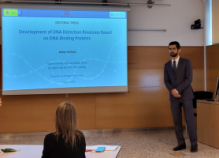Ankur Ruhela defends his PhD thesis
Ankur Ruhela did a great job defending his PhD thesis on the 'DEVELOPMENT OF DNA DETECTION BIOASSAYS BASED ON DNA BINDING PROTEINS' today Friday 24th of November 2023. His thesis was supervised by Dr. Ioanis Katakis and Dr. Lluis Masip.
DNA binding proteins (DBPs) are essential components of many biological processes. Their ability to recognize and bind tightly to DNA in a sequence-specific or non-sequence specific manner makes them ideal candidates as biorecognition elements. This work sought to explore different applications for these proteins in DNA detection. Synthetic and natural materials were used to immobilize the DBPs and facilitate target DNA capture and detection: carbon nanoparticles (CNPs), magnetic beads (MB), the horseradish peroxidase (HRP) enzyme, microtiter plates, and nitrocellulose membrane (NC). The proteins were engineered and produced recombinantly in Escherichia coli. The sequence-specific homodimeric Cro DBP from bacteriophage lambda was immobilized on CNPs and was used to detect multiplex PCR products with lateral flow dipsticks (LFDs). When immobilized on MB, it was demonstrated to capture, detect and purify double stranded DNA (dsDNA) PCR amplicons, similarly to the well-established streptavidin-MB, but without significant interference from single stranded DNA (ssDNA). For these applications, the specific DNA binding sequence of the DBP was incorporated in one of the PCR primers. On the other hand, the non-sequence specific heterodimeric histone-like HU DBP from E. coli was proposed as a universal bioreceptor and reporter for DNA detection, eliminating the need for primer modification or labeling. A novel single-chain format of HU was engineered and its binding affinity for dsDNA fragments was confirmed. The protein immobilized on microtiter plates or MB was used in conjunction with HU-HRP to detect unlabeled dsDNA. It was also immobilized on NC and used in an LFD with HU-CNPs for the same purpose. All these examples highlight the versatility of these biomolecules and their great potential in the field of DNA biosensors.
Update: 24/11/2024

